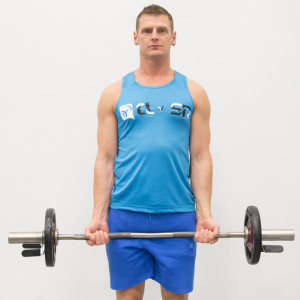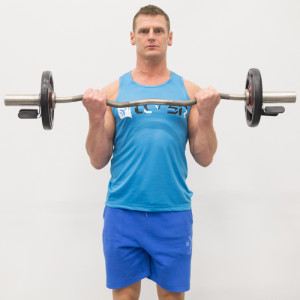EZ Bar Curl 21’s
Starting position:
- Grasp the EZ bar with a closed, slightly pronated grip (palms angled inward), to conform to the outer handles.
- Extend elbows, resting the bar or barbell on the front of thigh. Keep a slight bend in elbows.
- Stand up straight with feet shoulder width apart, keeping a slight bend in the knees.
- Keep upper arms tucked against torso and perpendicular to the floor.
Phase 1:
- Flex the elbows until you’ve reached mid range of motion (approximately 90 degrees of elbow flexion).
- Keep standing straight and upper arms tucked against side of torso.
- In a controlled fashion, allow elbows to extend, returning to starting position.
- Perform 7 repetitions from starting position to mid range of motion.
Phase 2:
- After completing the 7 repetitions in phase one, immediately proceed to completing 7 more repetition from mid range of motion (90 degrees of elbow flexion) to full elbow flexion.
- The descent (eccentric) phase of this range of motion stops at 90 degrees elbow flexion.
- Perform the partial reps in a controlled fashion, including the eccentric (descent portion) of the lift.
Phase 3:
- After completing the 7 repetitions in phase 2, immediately proceed to completing 7 full range of motion biceps curls.
- Control the eccentric portion of the lift.
- Continue to keep standing straight throughout the whole exercise, only the elbow joint is to be moving as it extends.
- Keep wrists straight throughout the exercise.
Exercise Data
FAQ'S & FACTS ABOUT EZ Bar Curl 21’s
What Are Biceps EZ-Bar Curl 21’s?
EZ Bar Biceps curl 21’s are a variation of the standing biceps curl in which the lift is broken down into three phases of repetitions, two of which of partial range of motion repetitions. The first phase consists of seven partial rep bicep curls from beginning to mid range elbow flexion. The second phase consists of seven more partial reps from mid range to full elbow flexion. The third phase consists of seven full range of motion biceps curls. The three phases are performed consecutively, without any rest in between.
This lift involves the primary elbow flexors, the brachialis and biceps brachii. This exercise is performed with an EZ bar. The concentric portion of the lift is elbow flexion, which involves the lifting of the weight. The eccentric portion is elbow extension, which involves the descent of the weight.
Why Do Biceps EZ-Bar Curl 21’s
The purpose of the EZ Bar Biceps Curl 21’s is to strengthen the biceps while promoting hypertrophy (increases in size) of the biceps. Performing partial repetition EZ bar biceps curls helps lifters target weak points in their biceps curls that can be applied when performing full range of motion EZ bar biceps curls.
The EZ bar is an alternative to utilizing a barbell. When strategically implemented in an exercise regimen, standing EZ bar curls complement other biceps curl exercises, providing a change in grip. This provides an advantage for optimizing the hypertrophy of the biceps. For example, when curling with a barbell, the grip is supinated (palms facing up). With an EZ bar, the grip is less supinated with palms facing inward. Elbow flexion performed in this position, with rotation of the forearms slightly inward, activates the long head of the biceps brachii. In addition, using an EZ bar places less stress on the wrists.
Anatomy Of Biceps EZ-Bar Curl 21’s
The biceps brachii is located on the front of the arm, originating at the shoulder and inserting in the elbow joint. It consists of two heads, the long head (outer biceps) and the short head (inner biceps). The long head tendon helps stabilize the shoulder joint and its origin is located at the tubercle and lip of the glenoid cavity of the scapula (shoulder blade). The short head origin is located at the coracoid process of the scapula. The long and short head unite as the muscle bellies run down the front of the arm. Both heads merge, sharing insertion into the radial tuberosity of the elbow joint.
The biceps brachii flexes the elbow joint and supinates the forearm. Supination refers to the simultaneous rotation of the wrist and elbow as the palm of your hand faces upward. Both heads of the biceps flex the elbow joint together, however, the EZ bar grip is less supinated, eliciting greater activation of the long head of the biceps brachii.
The brachialis lies underneath the biceps brachii, originating at the front of the lower end of the humerus bone. Its insertion is located at the coronoid process of the ulna at the elbow joint. The brachialis is a primary elbow flexor.
The brachioradialis aids the biceps brachii and brachialis, helping stabilize the elbow joint during biceps curls.
Although their contribution is minimal, forearm muscles, palmaris longus, flexor carpi radialis, and pronator teres contribute as weak flexors of the elbow joint.
The subscapularis works in conjunction with the other three rotator cuff muscles to stabilize the shoulder joint during this exercise.
Variations Of Biceps EZ-Bar Curl 21’s
Wide grip, narrow grip, reverse grip, standing against a wall, using an arm blaster.
How To Improve Your Biceps EZ-Bar Curl 21’s
EZ bar biceps curl 21’s are implemented in a training program to improve bicep exercise performance and strength gains. Strategically varying your grip width can optimize the benefit of 21’s when applied to traditional biceps curl exercises. Performing biceps curl 21’s with an EZ bar provides an alternative to performing the exercise with a barbell. Performing this exercise promotes gains in strength and hypertrophy of the biceps and brachialis.
Emphasis on eccentric contractions, prolonging the eccentric portion of the contraction, may also be incorporated in a training program focused on increasing strength. This should be implemented accordingly and with adequate muscle recovery as eccentric contractions cause substantial damage to muscle tissue.
It’s also important to note that EZ bar biceps curl 21’s may entail performing repetitions near failure/fatigue when approaching the 3rd phase. This has to be considered when designing your training regimen. It is important to allow adequate recovery days in between biceps training to allow muscles to repair.
Common Mistakes When Doing Biceps EZ-Bar Curl 21’s
Flexing and/or extending the wrists during elbow flexion. The wrists are to remain straight throughout the full range of motion.
Because this exercise typically entails lifting in a fatigued state, it is very common to observe an individual swinging their torso in efforts of lifting the weight with more ease. This compromises proper technique and biceps contraction. The biceps curl is a single-joint movement. The single-joint involved is the elbow joint. If you find yourself depending on momentum from swinging your torso to lift the weight, you may want to decrease the weight to prevent injury.
Standing on an unstable surface or with an unstable stance can also compromise technique. Your feet are your foundation and should be in a position of stability. If you are looking to maximize the contraction of your biceps, ensure that your feet are shoulder width apart with a slight bend in the knees. Stand on a flat surface. Standing with one foot in front of the other during a standing biceps curl can also compromise balance and decrease the potential for optimal muscle contraction.
Injuries Or Ailments & Their Effects Regarding Biceps EZ-Bar Curl 21’s
If proper technique is not adhered to (e.g. swinging of the torso, dropping the weight quickly instead of controlling the descent on the eccentric portion of the lift), the likelihood of back, wrist and/or biceps injury increases.
Although rare, biceps tendon rupture may occur if warm-up is not sufficient and/or if intensity (load) is increased inappropriately.
If proper recovery is not implemented between training days for optimal muscle repair of the biceps, the biceps tendon becomes inflamed. Without proper rest and treatment, the inflammation remains and results in biceps tendonitis.
Impingement syndrome and rotator cuff injuries, in general, are commonly associated with biceps tendonitis/biceps tendinosis. Therefore, it’s best to avoid bicep exercises when addressing impingement syndrome/rotator cuff injury unless advised by a physical therapist.





